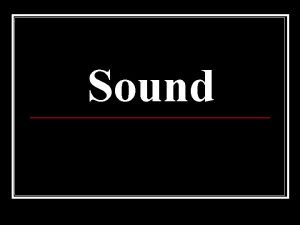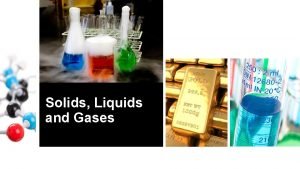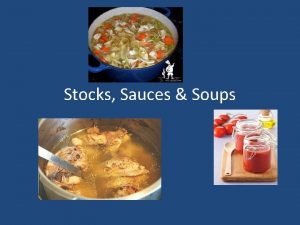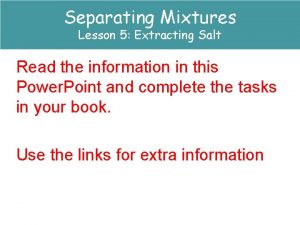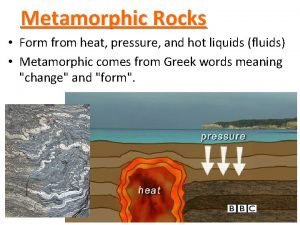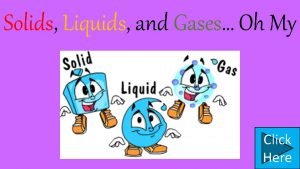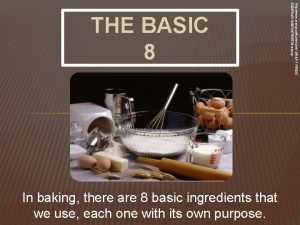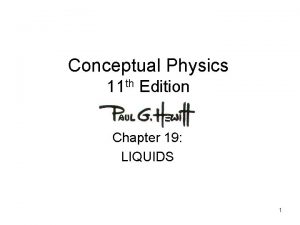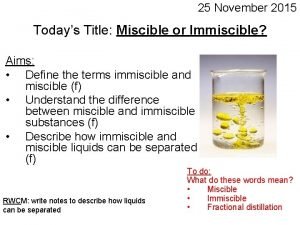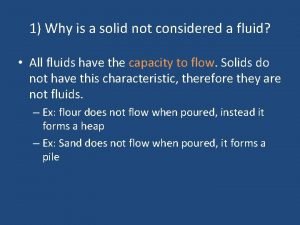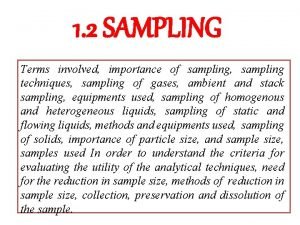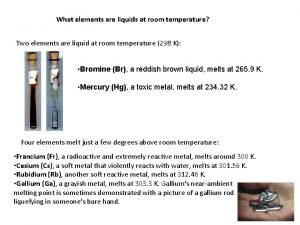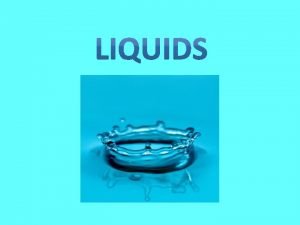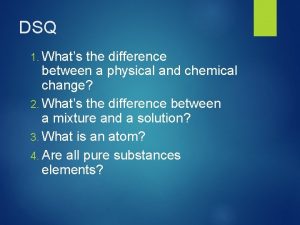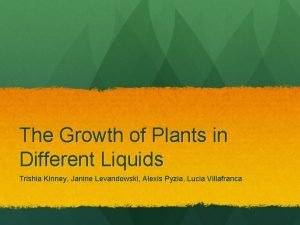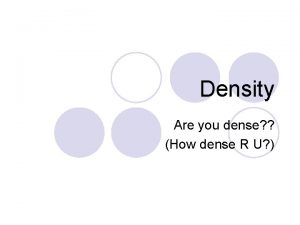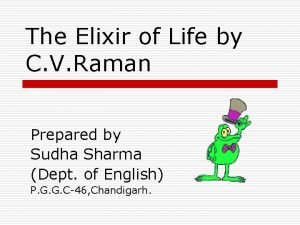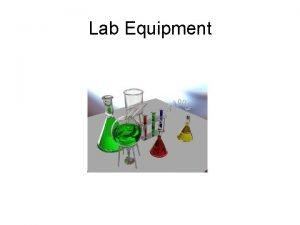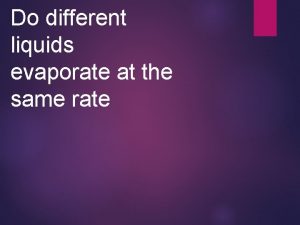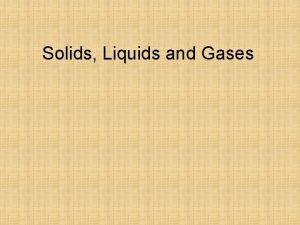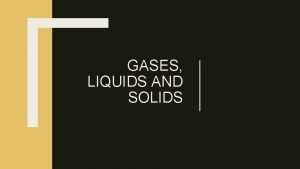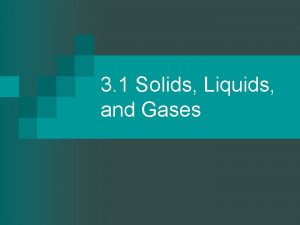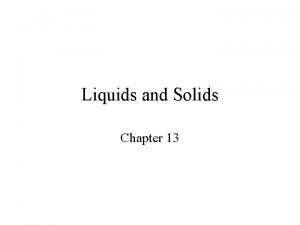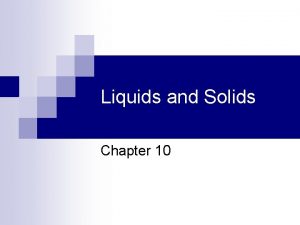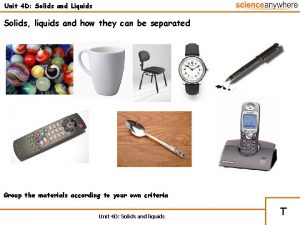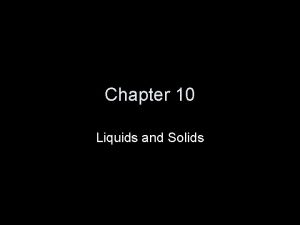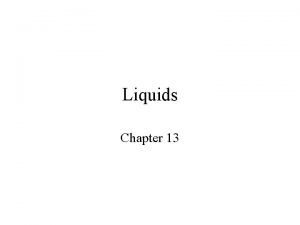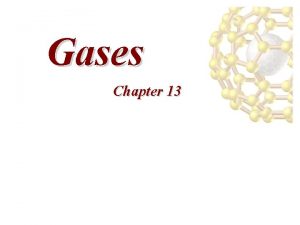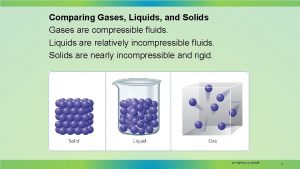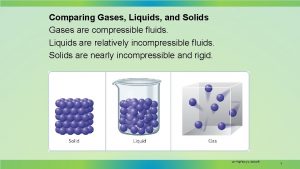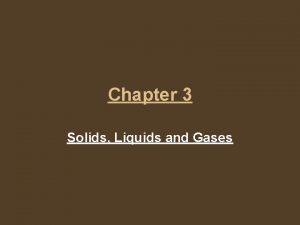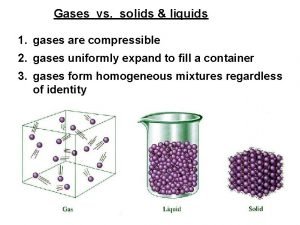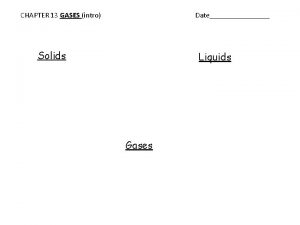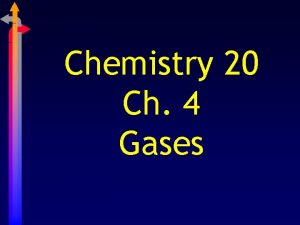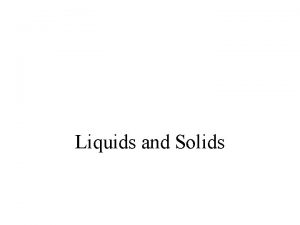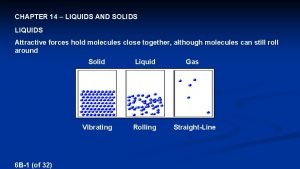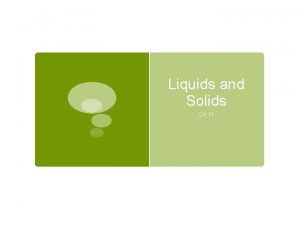Solids Liquids and Gases Solids s Molecules are





















































- Slides: 53

Solids, Liquids and Gases • Solids (s): Molecules are held in place by intermolecular interactions. • Liquids (l): Molecules are held next to one another by intermolecular interactions, however, these interactions are not strong enough to prevent the molecules from flowing past one another. • Gases (s): The intermolecular interactions are too weak to hold the molecules next to one another, so the molecules wander off on their own.

Diffusion is the spontaneous spreading out of a substance, and is due to the natural movement of its particles. Cotton wool soaked with hydrochloric acid Ammonium chloride Cotton wool soaked with ammonia solution Diffusion of ammonia and hydrogen chloride gases Ink being diffused in water


The mass of atoms are very small • Therefore scientists cannot count individual atoms or molecules directly • Instead a scientist count there particles by weighing a certain number of them • Same as a bank cashier, by knowing the weight of one coin they can calculate the number of coins by dividing the total mass by the mass of one coin.

A. What is the Mole? • A counting number (like a dozen) • Avogadro’s number (NA) • 1 mol = 6. 02 1023 items A large amount!!!!

The Mole • The mole is simply a chemist’s measurement for the amount of a substance. • It is a very large number (6 x 1023) as it ‘counts’ very small ‘objects’ such as atoms and molecules which have a very small masses. • This rather strange number was not selected deliberately – instead, it is the number of atoms in a sample of any element that has a mass in grams that is numerically equal to the elements atomic mass. • It allows chemists to work with masses in the lab which are feasible.

The Mole Definition A mole of any substance is defined as the amount of the substance that contains as many particles as 12 g of carbon – 12.

B. Molar Mass • Mass of 1 mole of an element or compound. • Atomic mass tells the. . . – – That 6. 01 *1023 atoms will weigh this amount 6. 01 *1023 atoms of carbons will weigh 12 grams per mole (g/mol) 1 mole of carbon is 12 grams per litre • Round to 2 decimal places

B. Molar Mass Examples • carbon 12. 01 g/mol • aluminum 26. 98 g/mol • zinc 65. 39 g/mol

B. Molar Mass Examples • water – 2(1. 01) + 16. 00 = 18. 02 g/mol – H 2 O • sodium chloride – Na. Cl – 22. 99 + 35. 45 = 58. 44 g/mol

B. Molar Mass Examples • sodium bicarbonate – Na. HCO 3 – 22. 99 + 1. 01 + 12. 01 + 3(16. 00) = 84. 01 g/mol • sucrose – C 12 H 22 O 11 – 12(12. 01) + 22(1. 01) + 11(16. 00) = 342. 34 g/mol

If a magnesium atom is twice as heavy as an atom of carbon Then 100 moles of magnesium Are twice as heavy as 100 moles Of carbon Therefore if we have a piece of Magnesium that is twice as heavy As a piece of carbon they have an Equal number of atoms

• Atom of carbon weighs • Mr=12 • Atom of hydrogen weighs • Mr=1 One gram of hydrogen atoms and twelve grams of Carbon atoms both have the same number of atoms

• Atom of silver weighs • Ar=108 • Atom of carbon weighs • Ar=12 If we have 12 g of carbon how do we calulate the mass of silver if it has the same number of atoms

12 g 24 g 27 g 40 g carbon magnesium aluminium calcium 56 g 63. 5 iron copper silver All these masses contain the same number of atoms Avogadro`s number = 6 X 1023 Symbol L It is the number of atoms of carbon in 12 g of the carbon-12 isotope 108 g

The amount of a substance which contains 6 X 1023 particles is called a mole of that substance Symbol mol

• One mole of carbon weighs 12 grams • One mole of carbon contains 6 X 1023 atoms • 48 g of Mg (one mole weighs 24 g) • Is 2 moles of Mg

Converting moles to grams • Mass of one mole of an element= relative atomic mass in grams Element H C N Mg Cu Fe I Relative atomic mass 1 12 14 24 63. 5 56 127

The mass of one mole of an element = Relative Atomic Mass in grams

The relative molecular mass of a compound is the sum of the relative atomic masses of all the atoms in the compound H 2 O = 2(1) + (16) = 18 (relative molecular mass of H 2 O) Cu. SO 4. H 2 O =(63. 5) + (32) +4(16) +5 (18)=249. 5

Converting Grams to moles • 12 g of carbon = 1 mole • 1 g of carbon = 1/12 moles • 36 g of carbon= 36/12=3 moles

How many moles of sulfuric acid (H 2 SO 4) are there in 12. 25 g of sulfuric acid • Relative mol mass =2(1) + (32) + 4(16) = 98 • Total mass/mass of one mole • 12. 25/98=0. 125 mole

Converting moles to number of atoms or molecules • How many atoms of sodium are present in 0. 25 moles of a metal • 1 mole of Na contained 6 x 1023 atoms • 0. 25 x 6 x 1023 atoms= 1. 5 x 1023 atoms


Molar Volume • One mole of any gas should occupy the same volume as one mole of any other gas at the same conditions of temperature and pressure. • Gases are often compared at STP, standard temperature and pressure. Standard pressure = 101325 Pa Standard temperature = 273 K • Molar Volume = 22. 4 L = 22, 400 cm 3 = 2. 24 x 10– 2 m 3


Relative Molecular Mass The relative molecular mass is the average mass of a molecule relative to one twelfth the mass of the carbon 12 atom. The relative molecular mass has no units as it is the ratio of two masses.


Molar Mass • The molar mass of a substance is the mass in grams of one mole of the substance. • The molar mass has the same numerical value as its relative molecular mass, but its units are grams (g). 1 mol of carbon, 12 g


More Mole Calculations Volume of X Number of particles of X (if a gas at STP) in litres at STP ÷ 6 x 1 x 1 0 23 2 2 ÷ 0 23 . 4 x Moles of X x molar mass ÷ molar mass Mass of X in g . 4 2 2 Notice that there is no direct link from particles to grams, you must first convert to moles. Likewise going from volume to mass.




Chemical Formulas

Empirical Formula • The empirical formula of a compound is the formula that gives that simplest whole number ratio in which the atoms of the elements in the compound are present. • The empirical formula of glucose, C 6 H 12 O 6 (ratio of atoms is 6: 12: 6) is CH 2 O, as this is the lowest ratio (1: 2: 1) of the atoms C, H and O.




Molecular Formula The molecular formula of a compound is the formula that gives the actual number of atoms of each element present in a molecule of the compound.


Percentage Composition by Mass If the empirical formula of a compound is known, the percentage by mass of each element present can be calculated. It can be useful to calculate the percentage of a certain element in a compound, for example the percentage of nitrogen in fertilisers.


Structural Formulas The structural formula of a compound shows the arrangement of the atoms within a molecule of the compound. Some Examples: Methane, CH 4 Ethene, C 2 H 4 Ethanol, C 2 H 5 OH You will come across many more structural formulas in the organic section of the course.

Chemical Equations

Chemical Equations • A chemical equation is a way of representing a chemical change. • It shows reactants and products. • To balance an equation means to change the numbers of each molecule involved, so that the same number of atoms of each element appear on the reactants side and on the products side. • Chemical equations balance on an atomic level, not molecular. • You cannot change the formula of a substance, i. e. if the equation has NH 3 you cannot change this you can only put a number in front of it, 2 NH 3, increasing the number of N’s and the number of H’s. • Never change the subscripts (small numbers). • It is possible to write balanced equations for lots of reactions but that does not mean that the reaction actually takes place.

Formation of Water (Oxygen does not exist as single atoms) (This reaction does not take place)

Balancing an Equation

Balance the following

Balancing Redox Equations • In working out what is oxidised and what is reduced in a reaction, it is important to remember that oxidation numbers are not a charge. • Write the oxidation numbers below each atom to which it applies, as shown in the examples. • Oxidation is an increase in oxidation number. • Reduction is a decrease in oxidation number.

Assign oxidation numbers to all the atoms in the equation. Write down half equations of what is oxidised and reduced. Attach subscripts to atoms oxidised and reduced and balance the half equations. Balance the half equations. Attach species that were attached to the oxidised and reduced atoms. Include all the original species and complete the balancing by inspection.

Calculations using Chemical Equations • A balanced equation for a chemical reaction gives the relative amounts of each reactant and each product involved in the reaction. • If the amount of one substance is known, based on the molar ratios in the equation, the amounts (masses, particles or volume)of other substances can be calculated. • Make sure to always work in moles.

 Expansion of solids liquids and gases examples
Expansion of solids liquids and gases examples Solids liquids and gases section 2 properties of fluids
Solids liquids and gases section 2 properties of fluids States of matter venn diagram
States of matter venn diagram 20 examples of liquids
20 examples of liquids Example of solid liquid and gas
Example of solid liquid and gas Lesson outline lesson 1 solids liquids and gases answer key
Lesson outline lesson 1 solids liquids and gases answer key Chapter 14 solids liquids and gases worksheet answers
Chapter 14 solids liquids and gases worksheet answers Kinetic molecular theory of liquids and solids
Kinetic molecular theory of liquids and solids Particle movement in solids liquids and gases
Particle movement in solids liquids and gases How does sound travel through solids liquids and gases
How does sound travel through solids liquids and gases Properties of solids liquids and gases
Properties of solids liquids and gases Motion of particles in solids, liquids and gases
Motion of particles in solids, liquids and gases Why is gas easier to compress than liquid and solid
Why is gas easier to compress than liquid and solid Insidan region jh
Insidan region jh Molecular theory of gases and liquids
Molecular theory of gases and liquids Arrangement particles of liquid
Arrangement particles of liquid Kinetic molecular theory of liquids and solids
Kinetic molecular theory of liquids and solids Liquids and solids menu
Liquids and solids menu Liquids and solids
Liquids and solids Chapter 11 - states of matter: liquids and solids
Chapter 11 - states of matter: liquids and solids Organic molecules vs inorganic molecules
Organic molecules vs inorganic molecules Filter medium resistance formula
Filter medium resistance formula The liquids that form the foundation of sauces and soups
The liquids that form the foundation of sauces and soups Thickened liquids that complement other foods
Thickened liquids that complement other foods Liquids dielectrics are mainly used as
Liquids dielectrics are mainly used as Miscible and immiscible liquids worksheet
Miscible and immiscible liquids worksheet Regional metamorphism
Regional metamorphism What are the 3 properties of a liquid
What are the 3 properties of a liquid What are solids
What are solids Ionic liquids green chemistry ppt
Ionic liquids green chemistry ppt Class k fire
Class k fire Phonetic transcription
Phonetic transcription Monophasic doses form used in other than oral cavity
Monophasic doses form used in other than oral cavity Liquid used for cooking
Liquid used for cooking Chapter 19 liquids exercises answers
Chapter 19 liquids exercises answers Why are liquids incompressible
Why are liquids incompressible Viscosity of liquids
Viscosity of liquids Miscible and immiscible definitions
Miscible and immiscible definitions Solid liquid and gas
Solid liquid and gas Concentric tube thief
Concentric tube thief How many elements are liquid at room temperature
How many elements are liquid at room temperature Kinetic molecular theory of liquids
Kinetic molecular theory of liquids Whats a physical change
Whats a physical change Plant growth with different liquids
Plant growth with different liquids How dense are you
How dense are you Uncountable nouns water
Uncountable nouns water 14. separating mixtures of liquids.
14. separating mixtures of liquids. Water an elixir of life essay
Water an elixir of life essay Maroon spoon dysphagia
Maroon spoon dysphagia Beaker tongs function
Beaker tongs function Nectar thick liquids walmart
Nectar thick liquids walmart Do all liquids evaporate at the same rate
Do all liquids evaporate at the same rate Sysco thickened liquids
Sysco thickened liquids Separation of immiscible liquids diagram
Separation of immiscible liquids diagram









